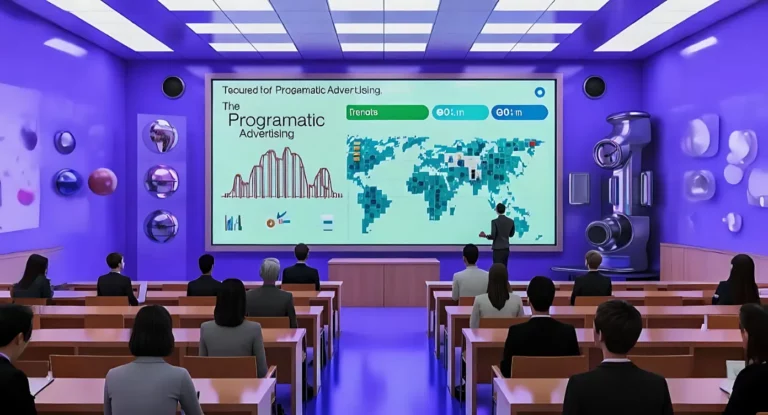How to Increase Your Blog Revenue with Programmatic Advertising
Monetizing your blog goes far beyond simply placing ads – it’s about creating an integrated experience that attracts readers and encourages other websites to link to your content. Programmatic advertising is a powerful tool that, when well-explored, can transform your blog into a steady source of income. Learn about the strategies that can take your blog to the next level!
Success begins with choosing a niche that combines passion and lucrative potential. Instead of opting for generic categories, focus on themes where there’s real interest from both advertisers and the public:
Finance and Investments: Cover topics like investments, insurance, personal finance, and even cryptocurrencies. This sector attracts advertisers willing to pay high premiums for impressions.
Innovative Technology: Detailed reviews, practical tutorials, and analyses of tech releases can yield high CPMs.
Holistic Wellness and Health: Content that goes beyond the basics – addressing new trends in nutrition and fitness – wins over readers and advertisers.
Digital Marketing and Online Trends: Discuss SEO, social media, and growth strategies, delving deeper into themes with case studies and links to statistical research that strengthen credibility.
Purposeful Travel: Instead of conventional guides, produce exclusive content with insider tips that facilitate partnerships and link-building collaborations.
2. Optimize Your Layout for an Engaging Experience
Your blog needs to be attractive to both readers and advertisers. Think of the layout as a tool to guide attention:
Strategic Ad Placement: Insert ads at strategic points – such as at the end of paragraphs, at the top, and on the side – without distracting from the main content.
Responsive and Clean Design: Ensure your blog is accessible on any device. An intuitive design keeps visitors Browse longer, increasing the value of ad spaces.
Intelligent Use of White Space: Empty space around ads helps them stand out and improves readability, creating a visually more pleasant environment.
A/B Testing with Various Formats: Experiment with banners, native ads, and videos. Make constant adjustments to find the balance between monetization and user experience.
3. Adopt Advanced Techniques with Header Bidding
Instead of relying on a single revenue source, header bidding allows multiple advertisers to bid in real-time, maximizing the value of each impression:
Stimulate Competition: Competition among various platforms can significantly increase CPM, ensuring you receive the best bid for each ad space.
Balance Revenue Sources: Diversify your partnerships to reduce risks and seize opportunities from advertisers that align with your audience.
Full Inventory Control: With header bidding, you can set minimum prices and even block unwanted advertisers, maintaining ad quality and blog credibility.
4. Create Rich and SEO-Friendly Content
Quality content is the engine of your blog – it’s what attracts readers, encourages links, and keeps advertisers interested:
Keyword Research Focused on the Target Audience: Go beyond generic formulas. Use SEO tools to identify specific terms that truly resonate with your audience and incorporate them naturally.
In-depth and Relevant Articles: Instead of superficial texts, produce posts that dive deep into the subject. Detailed stories, case studies, and in-depth analyses not only engage the reader but also encourage other sites to link to your content.
Optimized and Interactive Images: Use high-quality images with descriptive alt text. Interactive visual elements – such as infographics – enrich content and increase the likelihood of being shared.
Authentic Link Building Strategy: Encourage link creation by mentioning reliable sources, conducting interviews, or offering exclusive content that other blogs and websites want to reference.
5. Boost Your Results with Google AdSense
How to Boost Your Blog Revenue with Programmatic Advertising
Monetizing your blog goes far beyond simply placing ads – it’s about creating an integrated experience that attracts readers and encourages other websites to link to your content. Programmatic advertising is a powerful tool that, when well-explored, can transform your blog into a steady source of income. Learn about the strategies that can take your blog to the next level!
- Find a High-Demand Niche
Success begins with choosing a niche that combines passion and lucrative potential. Instead of opting for generic categories, focus on themes where there’s real interest from both advertisers and the public:
Finance and Investments: Cover topics like investments, insurance, personal finance, and even cryptocurrencies. This sector attracts advertisers willing to pay high premiums for impressions.
Innovative Technology: Detailed reviews, practical tutorials, and analyses of tech releases can yield high CPMs.
Holistic Wellness and Health: Content that goes beyond the basics – addressing new trends in nutrition and fitness – wins over readers and advertisers.
Digital Marketing and Online Trends: Discuss SEO, social media, and growth strategies, delving deeper into themes with case studies and links to statistical research that strengthen credibility.
Purposeful Travel: Instead of conventional guides, produce exclusive content with insider tips that facilitate partnerships and link-building collaborations.
- Optimize Your Layout for an Engaging Experience
Your blog needs to be attractive to both readers and advertisers. Think of the layout as a tool to guide attention:
Strategic Ad Placement: Insert ads at strategic points – such as at the end of paragraphs, at the top, and on the side – without distracting from the main content.
Responsive and Clean Design: Ensure your blog is accessible on any device. An intuitive design keeps visitors Browse longer, increasing the value of ad spaces.
Intelligent Use of White Space: Empty space around ads helps them stand out and improves readability, creating a visually more pleasant environment.
A/B Testing with Various Formats: Experiment with banners, native ads, and videos. Make constant adjustments to find the balance between monetization and user experience.
- Adopt Advanced Techniques with Header Bidding
Instead of relying on a single revenue source, header bidding allows multiple advertisers to bid in real-time, maximizing the value of each impression:
Stimulate Competition: Competition among various platforms can significantly increase CPM, ensuring you receive the best bid for each ad space.
Balance Revenue Sources: Diversify your partnerships to reduce risks and seize opportunities from advertisers that align with your audience.
Full Inventory Control: With header bidding, you can set minimum prices and even block unwanted advertisers, maintaining ad quality and blog credibility.
- Create Rich and SEO-Friendly Content
Quality content is the engine of your blog – it’s what attracts readers, encourages links, and keeps advertisers interested:
Keyword Research Focused on the Target Audience: Go beyond generic formulas. Use SEO tools to identify specific terms that truly resonate with your audience and incorporate them naturally.
In-depth and Relevant Articles: Instead of superficial texts, produce posts that dive deep into the subject. Detailed stories, case studies, and in-depth analyses not only engage the reader but also encourage other sites to link to your content.
Optimized and Interactive Images: Use high-quality images with descriptive alt text. Interactive visual elements – such as infographics – enrich content and increase the likelihood of being shared.
Authentic Link Building Strategy: Encourage link creation by mentioning reliable sources, conducting interviews, or offering exclusive content that other blogs and websites want to reference.
- Boost Your Results with Google AdSense
Google AdSense remains a robust platform for monetization when used intelligently:
Adaptive Ad Units: Use responsive ads that automatically adjust to different devices. This ensures full visibility and avoids distracting the reader.
Experiment with Sizes and Placements: Test layouts with various sizes – like 300×250, 336×280, or 728×90 – to discover which best suit your audience.
Automatic Ads for Optimization: Allow AdSense to use artificial intelligence to strategically position ads, maximizing relevance without compromising the Browse experience.
Constant Monitoring of Metrics: Use AdSense reports to understand the performance of each ad. Data like CPM and CTR allow for fine-tuning your strategy, ensuring continuous necessary evolution.
Conclusion
Transforming your blog into a monetization machine with programmatic advertising requires strategy, creativity, and persistence. By combining the choice of a lucrative niche with an optimized layout, modern techniques like header bidding, and high-quality SEO-focused content, you create an environment that attracts both readers and link collaborations. Remember: success comes with constant adaptation and refinement of strategies. Stay tuned to trends, invest in user experience, and watch your blog evolve into a true market reference.




